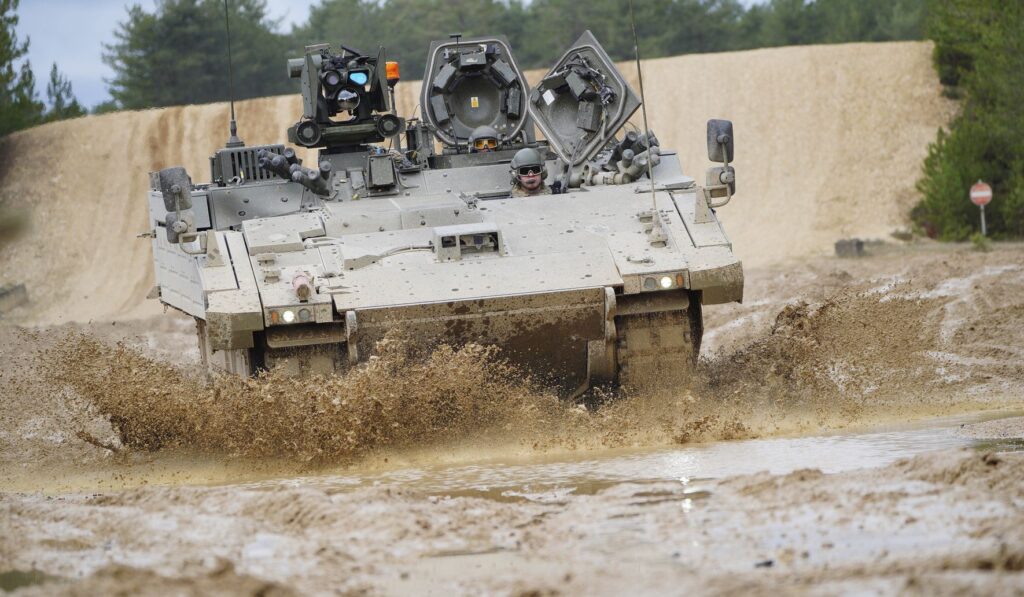The British army has announced Initial Operating Capability for the Ajax, its first new armored fighting vehicle in nearly 30 years, marking the start of limited operational use while further trials and integration continue.
The Ajax marks a major step forward in armored reconnaissance and troop protection for the British army. Built around modern sensors, protection suites and digital systems, the vehicle is aimed at giving commanders clearer battlefield awareness and crews better protection than older platforms. The Defense Ministry on Thursday formally declared Initial Operating Capability for the Ajax, a milestone that enables the army to begin using the vehicle in training and limited operational roles.
Ajax evolved from a long-running modernization effort designed to replace aging reconnaissance and tracked platforms. Work on the family of vehicles focused on improved situational awareness, survivability and networked communications, so crews can see farther and share data faster. Those aims reflect a shift from pure armored punch to information-driven battlefield performance, where sensors and data links matter as much as armor and guns.
The vehicle brings together a suite of sensors, cameras and battlefield management tools that feed a digital common picture to commanders and other units. That networked approach helps reconnaissance troops identify threats and hand off targeting data to other formations, which is especially valuable in complex, fast-moving environments. Ajax’s design also includes modular protection and active systems to help manage threats from mines, roadside explosives and small arms fire.
Initial Operating Capability does not mean Ajax is finished with testing or that the fleet is at full strength. IOC is a formal recognition that the vehicle is ready for limited use while crews train and engineers continue to work through remaining issues. The declaration lets units train on the platform in real-world scenarios, accelerating learning about maintenance needs, tactics and integration with other equipment.
The Ajax program has been visible in public debate because of its length and several technical challenges during trials. Like many ambitious military procurement efforts, it went through iterations to sort out vibration, power, and reliability questions during testing. Those problems required engineering fixes and more testing, but the move to IOC shows the ministry believes the vehicle is mature enough to start entering service in a controlled way.
For soldiers, Ajax changes daily routines: maintenance will rely more on digital diagnostics, crews will use displays and sensors rather than line-of-sight alone, and training will emphasize information-sharing as much as gunnery or maneuver. Workshops and logistic chains will adapt to new spare parts, software updates and supplier relationships tied to a modern, computer-heavy vehicle. That transition has costs, but it also promises a step change in capability for frontline reconnaissance units.
Operational commanders will use IOC Ajax vehicles to refine tactics and identify what further changes the fleet might need before larger-scale deployment. Those insights often lead to software tweaks, changes in crew procedures, or equipment upgrades that are easier to implement when units have hands-on experience with the platform. The path from IOC to full operational capability typically spans months or years, depending on training tempo and the extent of further adaptations required.
Beyond the vehicle itself, Ajax represents a broader shift in how the army views armored forces. Instead of only fielding heavily armored main battle tanks, modern forces balance mobility, protection and information dominance. Reconnaissance vehicles like Ajax are meant to find and fix the fight, feeding data to heavier platforms and remote shooters so the entire force can act more decisively and with fewer surprises.
The move to IOC will also inform procurement and support decisions, such as how many vehicles to field, which variants to prioritize, and how to sequence upgrades. Real-world use highlights where supply chains are stressed and where maintenance procedures need streamlining. Those practical lessons help planners avoid capability gaps and ensure forces can sustain operations when Ajax is called on in contested environments.
Training units will now run more realistic exercises with Ajax in the loop, exposing crews to the platform’s strengths and limitations under pressure. Those exercises are where doctrine evolves and where soldiers adapt machine capabilities into tactics that actually work on the ground. As the program moves forward, the army will collect data from these exercises to guide future upgrades and to shape how Ajax is employed alongside other assets.



